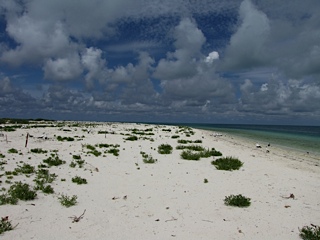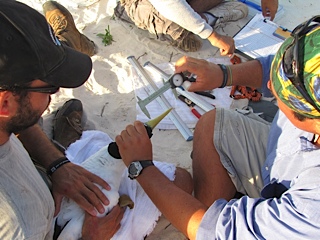On Isla Pérez, a lionfish floated in a tank of seawater, swimming in lazy circles. Isla Pérez is a small, hot, dry island in the Gulf of Mexico, part of the appealingly named archipelago Arrecife Alacranes, or Scorpion Reef. The island has no permanent human population, although there are temporary residents—members of the Mexican Navy and ecologists from a variety of non-governmental organizations.

Image: Arrecife Alacranes. Photo by author.
I had arrived on the island on a Mexican Navy boat earlier that morning, traveling with a group of scientists from Grupo de Ecología y Conservación de Islas, a Mexican NGO devoted to island conservation with particular expertise in invasive species eradication and the restoration of native ecologies. The NGO had come to the archipelago in order to study the flora and fauna in advance of a planned eradication project. I am an anthropologist, and I had joined the expedition in order to conduct participant observation research.[1] The lionfish in the tank—like the iconic palm tree many of us associate with tropical islands—was an invasive species. The presence of the fish was a reminder that while islands are imagined to be isolated and separate, they are densely connected to broader human and ecological worlds.

Image: Birds on Isla Muertos. Photo by author.
Islands have long played an important role in ecological research and thought. Famously imagined by Charles Darwin as natural laboratories, islands are often represented in scientific, social, and literary writing as isolated, self-contained, and pure. They are seen as utopian spaces, disconnected from the world around them. As historian John Gillis observes, the island has been seen as an “ideal venue for travel to bygone eras,” microcosms in which the past can be preserved.[2] This past may refer to ecosystems that have vanished from the mainland, or social formations, like the fishing cooperatives that remain active on a few Mexican islands.
The Mexican federal strategy for island conservation highlights islands as isolated exemplars of ecosystems, noting that they should be conserved not only for the way the expand the territory of the nation and the potential resources they offer in terms of biodiversity, but also because they are “extraordinary labs for ecological research and the modeling of the sustainable use of natural resources.”[3]

Image: Masked Boobie on Nest. Photo by author.
Someone had caught the lionfish in the waters off the island in the hours before my arrival. Native to the South Pacific and the Indian Ocean, the fish was quickly diagnosed as an invader in the Gulf of Mexico and aside from a certainty that it should not be released, no one seemed quite sure what to do with it. American authors have made a tongue in cheek proposal that perhaps the best response to the lionfish’s invasion would be a “gastronomic counteroffensive,” and the NGO Reef Environmental Education Foundation published The Lionfish Cookbook: The Caribbean’s New Delicacy with the goal of enticing consumers to eradicate the invader, one meal at a time.[4]

Image: Newly hatched turtle heading towards the sea. Photo by author.
A few days later, I joined a couple of scientists on a trip to another island in the archipelago, Isla Desterrada, to count turtle nests. Walking across Desterrada’s white sand looking for signs indicating the presence of turtles, I spotted two palm trees at the far end of the island. While the palm trees fit with my idealized vision of what a tropical island should look like, they too were considered invasives, taking root after coconuts washed up on the island. Lacking a trained eye for the native vegetation of Arrecife Alacranes, and given my cultural expectations of what might find on a tropical island, I failed to recognize these trees as invasives, although the scientists I was with were quick to point out that these were species out of place.

Image: Measuring and Tagging Masked Boobies. Photo by author.
The lionfish and the palm trees were reminders that the vision of islands as isolated model ecosystems is illusory. Instead, islands are connected to the world around them; the arrival of these invasives disrupted the image of the ocean as a boundary, demonstrating the ways in which it could also serve as a point of connection and passage. For the Grupo de Ecología y Conservación de Islas, the islands represented a place where the past could be recovered and where it might be possible to undo the mixing and homogenization of the environment that contemporary globalization and capitalism have wrought. Observing the work of the scientists, I saw the human effort that was required to produce islands as isolated and uncontaminated exemplars of the natural world. In order to make these islands into exemplars, their borders were policed, human access controlled and limited, and ecosystems carefully managed. Conservationists and scientists have spent years making Mexican islands into model ecosystems and ecological laboratories. They have carefully removed some species and coaxed others to return, in the process demonstrating the extensive human labor required to produce isolated, uncontaminated nature.
All photos are by the author.
Footnotes
[1] For more on these eradication projects, see Emily Wanderer, “Biologies of betrayal: Judas goats and sacrificial mice on the margins of Mexico,” BioSocieties 10 (2015): 1-23.
[2] John Gillis 2004 Islands of the Mind. New York: Palgrave Macmillan: 123-124.
[3] Alfonso Aguirre Muñoz et al. 2012 Estrategia Nacional para la Conservación y el Desarrollo Sustentable del Territorio Insular Mexicano. Mexico City: Instituto Nacional de Ecología.
[4] Nathan Thornburg, “The lionfish is delicious. And it needs to die,” Slate, March 16, 2011, http://www.slate.com/articles/life/food/2011/03/the_lionfish_is_delicious.html.
Emily Wanderer is an Associate Editor at the CASTAC Blog, and an anthropologist of science and medicine. She is currently a visiting lecturer at Wellesley College. Her research focuses on biopolitics and biosecurity, particularly in Latin America.

2 Trackbacks